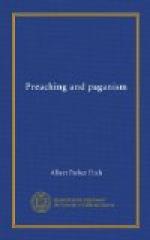The humanist, then, critically studies nature and mankind, finding in her matrix and in his own spirit data for the guidance of the race, improving upon it by a cultivated and collective experience. The naturalist uncritically exalts nature, seeks identification with it so that he may freely exploit both himself and it. The faith of the one is in the self-sufficiency of the disciplined spirit of mankind; the unfaith of the other is in its glorification of the natural world and in its allegiance to the momentary devices and desires of the separate heart. It will be borne in mind that these definitions are too clear-cut; that these divisions appear in the complexities of human experience, blurred and modified by the welter of cross currents, subsidiary conflicting movements, which obscure all human problems. They represent genuine and significant divisions of thought and conduct. But they appear in actual experience as controlling emphases rather than mutually exclusive territories.
Now, the clearest way to get before us the religious view of the world and the law which issues from it is to contrast it with the other two. In the first place, the religious temperament takes a very different view of nature than either romantic, or to a less degree scientific, naturalism. Naturalism is subrational on the one hand or non-imaginative on the other, in that it emphasizes the continuity between man and the physical universe. The religious man is superrational and nobly imaginative as he emphasizes the difference between man and nature. He does not forget man’s biological kinship to the brute, his intimate structural and even psychological relation to the primates, but he is aware that it is not in dwelling upon these facts that his spirit discovers what is distinctive to man as man. That he believes will be found by accenting the chasm between man and nature. He does not know how to conceive of a personal being except by thinking of him as proceeding by other, though not conflicting, laws and by moving toward different secondary ends from those laws and ends which govern the impersonal external world. This sense of the difference between man and nature he shares with the humanist, only the humanist does not carry it as far as he does and hence may not draw from it his ultimate conclusions.
The religious view, then, begins with the perception of man’s isolation in the natural order; his difference from his surroundings. That sense of separateness is fundamental to the religious nature. The false sentiment and partial science of the pagan which stresses the identification of man and beast is the first quarrel that religionist and humanist alike have with him. Neither of them sanctions this perversion of thought and feeling which either projects the impressionistic self so absurdly and perilously into the natural order, or else minimizes man’s imaginative and intellectual power, leveling him down to the amoral instinct of the brute. “How much more,” said Jesus, “is a man better than a sheep!” One of the greatest of English humanists was Matthew Arnold. You remember his sonnet, entitled, alas! “To a Preacher,” which runs as follows:




